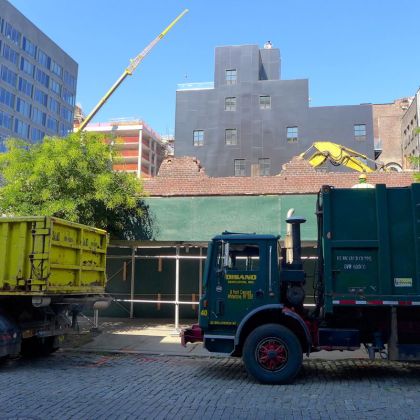Help Save Tribeca Before It’s Too Late
 If you’ve been paying attention at all lately, you’ll have noticed that much of Tribeca is being torn down (or about to be), in order to be replaced by buildings that are out of character and out of scale. (And it’s been going on for a while.) The city needs to expand the historic districts, or at least entertain the possibility, before our neighborhood becomes indistinguishable from the Upper West Side. I have no affiliation with Tribeca Trust—and you may not agree with every position the organization takes—but it’s leading the charge and if you love Tribeca you must get on board.
If you’ve been paying attention at all lately, you’ll have noticed that much of Tribeca is being torn down (or about to be), in order to be replaced by buildings that are out of character and out of scale. (And it’s been going on for a while.) The city needs to expand the historic districts, or at least entertain the possibility, before our neighborhood becomes indistinguishable from the Upper West Side. I have no affiliation with Tribeca Trust—and you may not agree with every position the organization takes—but it’s leading the charge and if you love Tribeca you must get on board.
Here’s a letter from Tribeca Trust that explains what you can do. Don’t shrug and assume it’s a lost cause, because it’s not. Don’t tell yourself that your voice won’t matter, because it will—all political groups respond more favorably to numbers. (So share the letter on Facebook, Twitter, Instagram, whatever.) Don’t give up without a fight.
Dear Tribeca Neighbors,
Given the scale of the recent demolition in our neighborhood, Tribeca’s future is hanging in the balance. If we don’t act now to extend the boundaries of our Historic Districts, it may be too late.
Hundreds of important buildings in Tribeca were left out of the first Historic District designations in 1991-93. Tribeca Trust has done the necessary research on those unprotected buildings to prove that they merit inclusion in our Historic Districts. We have given the Landmarks Preservation Commission our research and maps detailing what should be protected. As a result, the LPC has now granted Tribeca Trust a meeting to discuss the issue.
Please take a minute to take action for Tribeca. You can:
- Click on this link and fill out the form to send a message to the new Chair of the LPC, Ms. Meenakshi Srinivasan: nyc.gov/html/mail/html/maillpc.html
- In the Message section, paste the following (and feel free to add other comments or thoughts):
Dear Ms. Srinivasan,
Please calendar Tribeca immediately for a hearing to expand its Historic Districts.
Sincerely,
[Your Name and Affiliation]
- Share this message with your neighbors and friends or post in your lobby.
Update: Comments have been turned off due to spam. To have them turned back on, email tribecacitizen@gmail.com.














Thank you Erik for posting this letter as well as encouraging residents to mobilize via letter writing and social media. You’re right, it is not too late!
Erik,
Thank you for helping to bring this to a forum.
We all need to speak up in order to save the neighborhood we love
Thank you
The upcoming meeting with the Landmarks Preservation Commission is the CRITICAL one, since there it will be decided if the Commission will consider extending the boundaries of the Tribeca Historic District. If they decide against such consideration, that is it. It’s over. So if any of us have ever thought about writing a letter but put it off until later, now is the time to take a moment to do so. It only takes a minute, but if 500 Tribeca residents took that minute, our voice would be heard.
Thank you.
Thanks for covering this, Erik. LPC has only agreed to hear us, which means listening. There is no agreement to actually do anything. So people should really speak up.
Those interested in the issues should also go to our website and see our latest article about how “Big Real Estate” gets their way in Tribeca, and elsewhere. (www.tribecatrust.org/blog)
I am currently working on an article about a small, magnificent hotel in Tokyo that is about to be destroyed so that the developer can build a new, larger, modernized hotel to accommodate the crowds expected for the 2020 Olympic games there. Because the hotel is very important to a lot of very accomplished people in the design field, its demolition is getting a lot of attention.
The developer says that the hotel is simply too small and out of scale with modern Tokyo. There are many new hotels being built in anticipation of the Olympics, and those developers will reap large profits from them. The successful persons who are trying to save the sixties-built hotel are arguing that if the developers will preserve it and build their huge, modern hotel elsewhere, they will be rewarded because there are plenty of extremely rich people in the design world who will keep the old hotel filled to capacity, even if rooms cost many thousands of dollars per night. I’m not qualified to comment on the economic vicissitudes of that argument. But they are making an impassioned case that the hotel is a design treasure, and must be “preserved for future generations”.
Essentially, the plea being made to the developer is to preserve the hotel as a kind of museum piece – or perhaps a more vivid comparison is to an ant in amber. The developer is saying it is aware of the charm of the original, but they are not in the business of preserving charming museum pieces, they are in the hotel business. The current state of things is that they are at loggerheads, but it is likely the developer will prevail.
I bring this up because it correlates with our situation in Tribeca. A city is a living, thriving entity. I don’t question the impulses of those who would like to preserve antique, low-rise buildings because they are charming, or possess “character”. I, myself, like some things that are utterly without value except as sentimental objects of adoration. But the argument that we are preserving something of value for future generations is disingenuous at best. The preservation will benefit only the tremendously wealthy, to preserve their exclusive community, to preserve their wealth. “Future generations” will have as much access to a preserved Tribeca as I have to Beacon Hill and other preserved neighborhoods like it. I can only stand at the gates and gaze.
I don’t think the economic reality should be ignored: Many have purchased extremely expensive real estate in this neighborhood. If developers build modern high-rises the population of the neighborhood will grow, the current “character” will be altered, and the value of the expensive real estate, which is highly exclusive in part because of its impracticality, will decline. I accept that as true. Impracticality costs, big time.
The question is what one feels makes a city vital. Beacon Hill in Boston is largely an area no one of ordinary or even very substantial means can even dream of residing in. In order to live in the prime buildings there one must be connected to one of the so-called “Boston Brahmin” families, and one must possess huge, one could say Pharaonic, wealth. It’s closed. It’s a museum piece in a vitrine. It’s lovely, but it no longer represents the vitality of Boston. It is a cultural dead zone. It is like Lenin’s tomb. (He looks so darned lifelike.)
I love this neighborhood very much, but can’t abide living in Lenin’s tomb. If you’ve read my rant to this point, I thank you. I wrote it mainly to get it off my chest, and appreciate the platform very much. I’m not looking to engage in argument. I’ve heard the opposing view, I understand it, but I’m unmoved by it.
Surely, there’s a middle ground…. I’d just like a sense that someone with some sort of power is able to say no when a new development obviously doesn’t belong here. As for economic inclusion, it’s not as if the towers sprouting up all around Tribeca are filled with affordable housing.
A middle ground would be worth considering, but have you heard any words of compromise? I have only heard the word “no” from preservationists. Not only to the height of buildings but to the very materials they may be made of. Do you recall the complaints about the proposed building on the north side of Leonard between W. B’way and Hudson? First it was too tall, then it was too glassy, then the glass was the wrong color… If we were talking about a tree, the “middle ground” would be a bonsai. No shade, no fruit, no birds.
Hi David,
Designating a Historic district does not prevent developers from building. It promotes new tasteful structures like the Greenwich hotel which fit the feeling of the neighborhood and prevents developers from building out of context ugly monstrosities like Truffles.
The scale of these structures are determined by FAR and other aspects of the DOB zoning and code.
I agree that New York is the vertical city and in some way we obviously need new development to keep it vital and vibrant.
The developers are making plenty of money (right now) and I think of this as a means of enforcing a modicum of taste and preserving at least some of the elements of our neighborhood which created the basic value which they are currently feasting on.
I agree with Erik that there is a middle ground
Thank you, Rohin. Your points are measured and well-taken, and I said that I didn’t write my little rant to start a back-and-forth. But constructive discussion is always worthwhile. I sincerely hope there is indeed middle ground.
I do feel compelled to mention that I recently did a piece on the newest penthouse accommodation in the Greenwich Hotel. Rack rates for the hotel begin at $635/night, and the PH I was writing about starts for a nominal $15,000 per night, but I was encouraged not to mention that because, in the words of the representative, there is no fixed top rate. It starts at $15K but is negotiated each time based on the person requesting the accommodation and scheduling.
I wouldn’t want to comment on the relative tastefulness of the Greenwich Hotel, but it is clearly representative of a very exclusive lifestyle. It is not open, welcoming, or generous of spirit in any sense I associate with the city I grew up in. Just as a little imaginative exercise I am currently envisioning what would be different if a developer had been allowed to build a huge glass and steel hotel building with 1000+ rooms there. To many it would undoubtedly be an eyesore and would diminish the value of the neighborhood. And the rooms would be cheaper. If Aunt Betty came to visit from Terre Haute she might possibly be able to stay there for a few days. It would make many people very unhappy, except for Aunt Betty’s family, which lives in a rent-stabilized apartment in Independence Plaza, and don’t have her sleeping on the couch because she can’t afford a hotel within an hour’s commute from them.
Tell Aunt Betty she can stay in NJ and take the water taxi into the city or she can take her chances swimming across the Hudson, hopefully, with properly inflated arm floaties. Unless you’re going to rewire the brains of every human being living and yet to come, Utopia will never exist and communism doesn’t work….well. The common ground is that some neighborhoods will be more exclusive and expensive than others. The Greenwich Hotel as a Holiday Inn Express? Yeah, no, thank you. There are other options. I’d rather have more nail salons than bars & restaurants with 2am or 4am drunken closings. I’d rather fly first class and have leg room and ice cream sundaes than sit 3 wide with Aunt Betty who may or may not have Ebola.
I grew up in NYC, lived in Boston for many years and like to visit Tribeca from time to time, especially to see my friend David Imber. I am an architect. It is true that the Beacon Hill is now only for the very rich, if considered only as a place to live, as I gather Tribeca is / is becoming. Beacon Hill remains an accessible cultural legacy, like a special library with old books. Tourists, students of architecture and urban design, local people who care about old neighborhoods, history buffs and historians – all of them can go visit, although they can’t, of course, open the front doors and enter the interiors without permission from a very wealthy person.
If you destroy the Beacon Hill you can’t read those books anymore. Boston’s West End was a similar historic neighborhood, right next to Beacon Hill. It was destroyed to make way for a lot of banal development at a time when people were very seriously worried about the viability of city life. Now cities have rebounded very fully and the West End has developed into an area no one visits except for pragmatic reasons.
One of the problems here is the very difficult one of reconciling growth and vitality with respect and care for history. It is not merely an economic question or a question of nostalgia, although both of these are importantly involved. Engaging the complexity of a ‘both / and’ type of solution is the (endlessly recurring) challenge if we want to preserve important elements of our built cultural history without stifling the vitality (and sometimes raw beauty) of growth and development.
Eytan you are Spot on! Well put.
I fully understand the frustrations of people who have been living in this neighborhood since the 1970’s finding it frustrating to be out priced and essentially crowded out.
Rest assured that I too prefer an interesting and diverse neighborhood versus one that is just stuffed full of bankers.
I don’t know what we can do in this regard other than having the city incentivize developers to maintain below market rate apartments.
However I feel we all bear some responsibility to exercise our rights as citizens of Tribeca and make clear our concerns regarding the onslaught of tasteless new development.
I feel Christine Quinn really screwed NW Tribeca with her irrational support of variances for fugly Truffles with no corresponding “give backs” received from the developer in terms of look and finish (cough city council brown bag)
And so we have a permanent blight smack dab in the middle. Not a good move.
Obviously as a neighborhood we need to grow and develop. Empty lots benefit no one. The point is that it should be done with some taste and a general regard and appreciation for what makes this neighborhood special.
David I truly appreciate where you are coming from but veritably burning the neighborhood down with bad development so that Aunt Betty can pay $150 a night (imagine that !) is not a good long term strategy here. Rest assured even the “inexpensive” hotels an developments you seem to envision are already far far out of her reach (please check the rates and you will see what I mean)
Thank you all for the excellence of this debate. Both sides make important points. We need to preserve our heritage as inspiration as well as history. But also we need to move forward and not live in a “disneyworld” kind of encampment. It is hard to choose and a middle course can too often be simply watered down.
But one thing must be added to both, or all three, sides of the debate: affordability. If we keep all of Manhattan as a Museum, only a few can afford it. If we rebuild in tall modern splendor, only a few can afford it. Where will the budding artists, architects, engineers, writers, CREATORS, live?
This debate is not about affordability…but let us never forget that the creators are often those who make neighborhoods livable and attractive and are the first to be forced out by those who do not deem housing as a necessity. New York without its creators? Not the city I have loved for 78 years.
P.S. And yes, I really am named Aunt Betty.
WTF? There are no other places on planet Earth for budding artists, architects, engineers, writers, and precious CREATORS to live other than Manhattan 10013?!! What happens if the ocean levels keep rising?!!!
I’ll also have to check my eyeglass prescription because those historical photos & stories of Tribeca in the ’70s and ’80s really don’t depict a very ‘livable and attractive” neighborhood.
The “creators” are always the first to forget that it was the building owners and developers that make places livable & attractive and allow for businesses and people (of all backgrounds & professions) to make a neighborhood.
If you bought property back then you wouldn’t be complaining, but if you were just renting, well then I can see why you choose to complain. It’s always great to get bumped up to first class on a coach ticket. How cool is it to eat ice cream sundaes at 40,000 ft with DirectTV?!!! Hold the walnuts, I have a nut allergy.
Hey Jim, and with gentrification comes STROLLERS! We all know how you love those, right?
Ah yes…Tribeca pre-1970s. Oh, wait, there was no such place. There was the fabulous Washington Market. Fascinating. Yes. Vital. Yes. Urban. Yes. Beautiful…wellll…beauty is in the eye of the beholder and those old buildings were lovely once you got past the squashed lettuce leaves, tomatoes, rats, and the broken bottles of cheap booze of the haulers who worked until they had enough money for one of those flat bottles of rotgut and then collapsed in a sorry heap.
City life is fascinating because it is ever changing. The Market is gone. It was replaced by something wonderful. That is being replaced now. The Tribeca Trust, no doubt, is trying to hold on to what’s best in the face of change. Daunting and admirable. But miles ahead of developers’ ugly towers.
Thank you for highlighting this Erik. I have sent my letter via the link you attached. BG
Hey Erik, Thanks for this! I remember when Tribeca was a vibrant blue collar working area. And when Soho was actually an Italian neighborhood where in summer nights, people would set up card tables outside and grills and spend the night outside. When the Lower East Side was a place, well, I wouldn’t go. But I miss those days and it would be wonderful if the buildings in our neighborhood would at least be reminders because obviously there is no turning back the clock. Just think when we all travel, we go to the “real” neighborhoods. On the path we’re on, the only “real” neighborhood will be the West Village and maybe LES. Let’s at least let our architecture remind us of what NY used to be.